Pros
Cons
Introduction
Design & Appearance
{{section_header}}{{section.name}}{{/section_header}}
While the Samsung NX200 features a somewhat blocky design that contrasts hard edges with an accommodating curved grip, the NX20 sports an almost DSLR-like profile. It has a grip that more naturally aligns with the curvature of the hand, without the rough plastic material that gave purchase when handling the camera.
In shooting with the NX20 during a recent trip to Samsung's HQ in Seoul, South Korea, we found the the camera handled well, with a body that doesn't feel much larger than competing compact mirrorless cameras. The addition of an electronic viewfinder is certainly welcome, though its SVGA resolution did feel a little lacking compared to competing finders on some other models. We did find the mostly plastic construction of the buttons and some body sections (especially the OLED screen housing) to feel a little chintzy, even though the overall camera felt solidly built.
The body design is a nice mix between the newer NX200 modern style and the earlier NX cameras with more curved features. With so many retro-styled options on the market the NX20 stands out from the crowd, sticking to the design philosophy that now permeates the entire NX camera range. The result is a compact system camera that just feels like a shrunken down DSLR, similar to Panasonic's GH range of mirrorless cameras, but with a slightly more premium feel.
Tour
{{section_header}}{{section.name}}{{/section_header}}




Menu
{{section_header}}{{section.name}}{{/section_header}}
While the NX20 we were able to shoot with in Korea didn't have a finalized menu system, the general feel we got was that it was going to be practically identical to the NX200. It's organized into tabs that are lined horizontally along the top edge of the screen, with tabs for camera settings, video, custom, setup, and WiFi. The menu gives you access to all the basic settings of the camera, with the OLED screen making text look nice and crisp and easy to read.
Ease of Use
{{section_header}}{{section.name}}{{/section_header}}
The NX20 incorporates many of the same features as the NX200, with Samsung's typical SMART auto mode. Also included, of course, is Samsung's i-function lens compatibility. This gives you the ability to make adjustments to various settings by pressing a dedicated button on the lens itself, twisting the focus ring to control the setting on the fly. That also combines with the same live control panel we saw on the NX200, giving you a total readout on current shooting settings, letting you make adjustments with a simple turn of the top control dial.
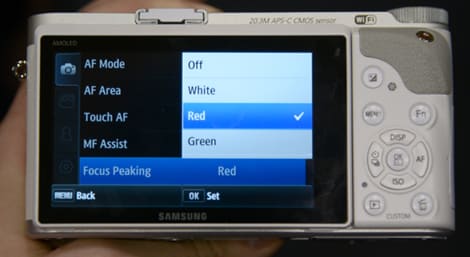

Size & Handling
{{section_header}}{{section.name}}{{/section_header}}
The Samsung NX20 is slightly larger than the NX200, with a grip that is reminiscent of a smaller DSLR. The grip fits comfortably in the hand, with a smooth material on the front that is easy to grip. It doesn't have a large rubberized, plush feeling like the NEX-7, but the camera doesn't feel like it's ready to slip out from your hand.
The NX20 is a good size overall. It's certainly not pocketable, but it feels light enough to keep around your neck for an extended shooting trip. We imagine it would be appealing to those looking for a camera for travel, with the articulated screen and electronic viewfinder combination enough to frame in just about any lighting condition.
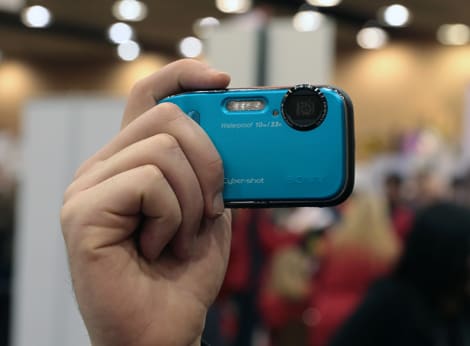
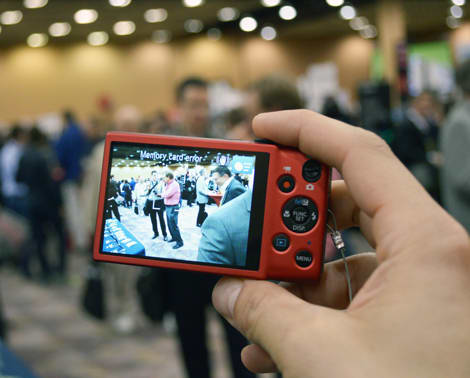
Modes Overview
{{section_header}}{{section.name}}{{/section_header}}
The Samsung NX20 includes a dedicated mode dial on the top plate of the camera, just to the right side of the viewfinder. The dial includes options for all the usual PASM modes, custom, WiFi, lens priority mode, scene selection, SMART auto, and video recording.

Auto Mode
{{section_header}}{{section.name}}{{/section_header}}
When shooting with the Samsung NX20, you can let the camera decide what exposure settings to use in most of the modes, with program auto and SMART auto both making those decisions for you. The difference is SMART auto (yes, they use all caps) will lock the user out of some control options, while detecting a particular scene and applying some preset adjustments. The program auto will work fine for most shots, though if you know you're shooting a common scene—a sunset, for example—the camera can pick that up and adjust accordingly.
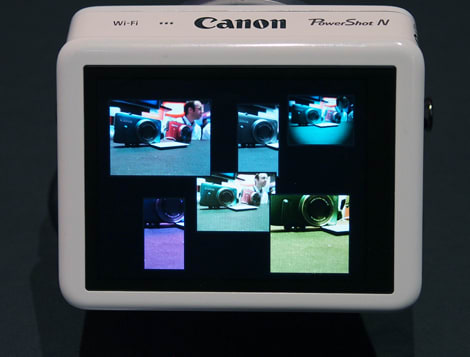
Movie Mode
{{section_header}}{{section.name}}{{/section_header}}
The Samsung NX20 is capable of capturing video at 1080/30p, with a dedicated video mode on the dial and a button for initiating recording on the back of the camera. With the same image sensor (though slightly tweaked processing), we expect video to be approximately the same quality as on the NX200. On the NX200, we saw very sharp video though some moire issues that may have been improved. Until we get the camera in our labs for a full test, we won't be sure.
Drive/Burst Mode
{{section_header}}{{section.name}}{{/section_header}}
The Samsung NX20 features a burst capability of up to 8 frames per second, despite the camera taking massive 20.3-megapixel images. This puts it up amongst the fastest mirrorless cameras in its class, and is a pretty firm swipe at Sony Alpha NEX-7 territory. The camera also responds (according to Samsung's own claims) with a delay of just 40ms, giving it a snappier feel.
Playback Mode
{{section_header}}{{section.name}}{{/section_header}}
Playback on the NX20 is pretty standard, with a dedicated playback button on the back of the camera just beneath the rear control dial. The pre-production model that we played with in Korea allowed for some basic editing of photos, in line with what we've seen on previous NX models. This gave you the ability to apply some creative filters to photos to bring up contrast, highlight certain colors, or alter your images without the need for a computer.
Picture Quality & Size Options
{{section_header}}{{section.name}}{{/section_header}}
The Samsung NX20 shoots full 20.3-megapixel images, with options for RAW, JPEG, and RAW+JPEG at reduced resolutions. One issue we saw on the NX200 that we've been told has been remedied is the extremely large RAW files. While we'll have to see for ourselves, we were a little alarmed at the massive files sizes individual RAW shots had with the NX200, with a full JPEG preview image included in each file. The maximum resolution was 5472 x 3080, with options shrinking that as low as 1024x1024 per image.
Other Modes
{{section_header}}{{section.name}}{{/section_header}}
Built-in WiFi
The WiFi functionality built right into the Samsung NX20 works very similarly to other cameras in Samsung's lineup. The camera can access a wireless network to push content directly to social media, or it can be used to link up with a smartphone, pushing content to the phone. With your images on your phone or tablet, you can then push those shots directly to online services. We didn't get to try out the WiFi during our short shooting stint with the camera, but we'll have a full report when we get a production-level camera.
Focus
{{section_header}}{{section.name}}{{/section_header}}
Like other mirrorless cameras, the Samsung NX20 utilizes contrast-detection autofocus in order to lock in on subjects. The focus on the NX20 allows for continuous AF, single AF, and manual focus if need be. In addition, the NX20 can lock in on a single spot, an area, or a face if you're taking portraits. Focus was quite snappy on the NX20 when we shot with it outdoors on a very overcast day, with very little hunting required, even when we moved indoors to a low-light situation.
Exposure & Metering
{{section_header}}{{section.name}}{{/section_header}}
The Samsung NX20 utilizes a 221-segment block metering system, with the option to utilize spot, center-weighted, or multi-segment metering. The camera has an effective metering range of 0-18EV at ISO 100, with the ability to set shutter speeds ranging from 30 seconds to 1/8000th of a second (bulb mode also available). You can compensate for this automatic exposure at +/- 3 stop segments.
ISO
{{section_header}}{{section.name}}{{/section_header}}
The Samsung NX20 has an effective ISO range of 100-12800, selectable in whole or 1/3rd-stop increments. You can select the ISO speed manually or utilize the auto ISO function to let the camera select it for you, with an upper limit that the user can set as high as ISO 3200.
White Balance
{{section_header}}{{section.name}}{{/section_header}}
When moving between different lighting situations you can adjust the NX20's white balance by selecting from a number of preset options. These include daylight, cloudy, fluorescent (W, N, and D, according to Samsung's specs), tungsten, flash, and direct kelvin entry. You can also set white balance automatically, or use custom to take a white balance reading and apply it to your shot.
Image Stabilization
{{section_header}}{{section.name}}{{/section_header}}
The Samsung NX20 doesn't include any stabilization in the body itself, with Samsung instead relying on lens-shift stabilization in their lenses. In the camera you have the option to control this, with two modes (or off) selectable. The system works by shifting a lens element inside the lens, counteracting any movement that the camera is currently doing. The result is a stabilized image, which will be stabilized on the rear screen and in the viewfinder.
Picture Effects
{{section_header}}{{section.name}}{{/section_header}}
The Samsung NX20 uses the company's "picture wizard" functionality to let you alter color and tone of your images during or after capture. These modes include standard, vivid, portrait, landscape, forest, retro, cool, calm, classic, and custom modes. In each of these modes you can adjust contrast, sharpness, saturation, and color, tweaking each as you like.
Lens Mount & Sensor
{{section_header}}{{section.name}}{{/section_header}}
The Samsung NX mount has developed quickly since its launch back in early 2010, allowing for the use of compact lenses on compact bodies with APS-C sized image sensors providing the image quality. The system has moved at a steady pace and, like most mirrorless cameras, finds more success overseas in than in the U.S. and Canada. That is changing slowly, with the NX lens family developing. The main feature of the NX lenses that sets them apart is their "i-function" button, which is located right on the barrel of the lens. This lets you quickly adjust certain settings; pressing the button brings up the scroller on the rear screen, while turning the manual focus ring adjusts things like shutter speed, aperture, or ISO right from the lens.
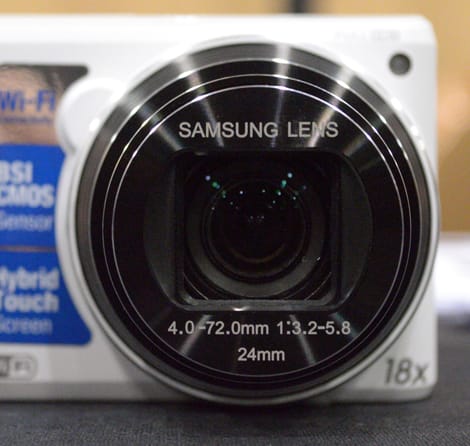

LCD & Viewfinder
{{section_header}}{{section.name}}{{/section_header}}
The rear screen on the Samsung NX20 is a 614k dot OLED display with an articulated hinge on the left side of the screen. This lets you swing the display out from the body, twisting it to face up, down, or even forward so the camera's subject can see themselves being framed. The screen is highly detailed, showing color with a high level of contrast and nice, crisp text. It is apparently a PenTile display, which is a Samsung trademark that apparently offers subjectively higher resolving power despite having fewer actual pixels than the competition.

The electronic viewfinder on the Samsung NX20 is an 800x600 SVGA display with approximately 1.04x magnification and a 100% field of view. It reads out directly from the sensor, which gives it a slight hitch when framing. Once you've locked in focus and exposure, it tends to speed up, offering a decent preview of what your image will look like. It still doesn't hold up to using an optical viewfinder, but as far as electronic finders go it's not bad.

Flash
{{section_header}}{{section.name}}{{/section_header}}
The Samsung NX20 features a built-in, pop-up flash with a guide number of 11 at ISO 100. This puts it among the more powerful built-in strobes on a mirrorless unit (most have a guide number of just six). The flash pops right up from the body on the viewfinder housing, though it doesn't have a bounce to it. You can apply flash compensation of +/- two stops, with the camera able to sync with the flash at shutter speeds of 1/160th and slower. The camera also includes a dedicate hot shoe, with the option to use external flashes if you desire.

Jacks, Ports & Plugs
{{section_header}}{{section.name}}{{/section_header}}
The side of the NX20 includes ports for both micro-HDMI and micro-USB 2.0 cables, inside of a plastic flap on the right side of the body. This is in addition to the dedicated hot shoe on the top of the camera. The NX20 is compatible with both external releases and an external mic, though the mic connection an optional accessory that attaches to the hot shoe.
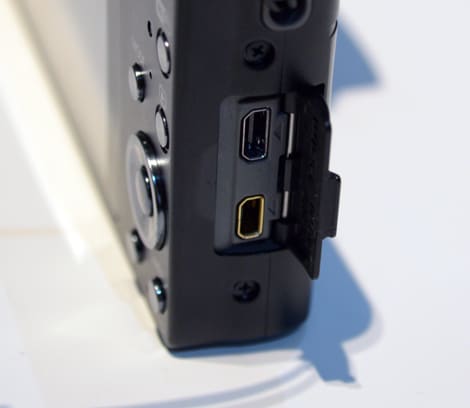
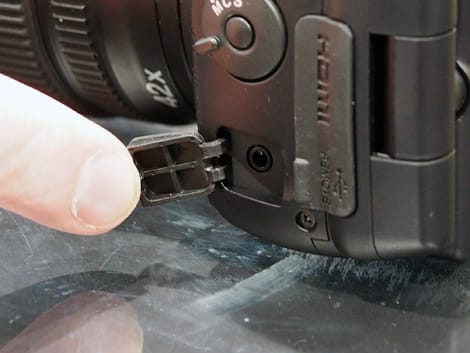
Battery
{{section_header}}{{section.name}}{{/section_header}}
The Samsung NX20 uses the BP1310 battery pack, with a 1300mAh capacity. The battery slots into a compartment on the bottom of the camera, with where the grip is. Samsung's provided CIPA rating puts the battery life at 360 shots, though typically normal use will get you quite a bit beyond that, especially if you're burst shooting quite a bit.

Memory
{{section_header}}{{section.name}}{{/section_header}}
As one of the largest (if not the largest) makers of SD memory in the world, it's no surprise that it's SD all the way on the Samsung NX20. In this case, it's SD/SDHC/SDXC memory cards, with a guaranteed functionality up to 128GB. The memory cards slot into the same compartment as the battery, on the bottom of the camera on the grip-side of the body.

Other Hardware
{{section_header}}{{section.name}}{{/section_header}}
WiFi
The WiFi functionality on the camera functions with 802.11n support, allowing for rapid transfer of information to and from the camera. The WiFi features include auto PC backup, the ability to connect to a wireless network, the option to push content to social media directly, or to function as a node for other devices to connect to.
Conclusion
The Samsung NX20 enters the ever-growing compact system camera market, taking the flagship line of the company's mirrorless interchangeable lens cameras in a more traditional direction. With its built-in EVF and WiFi functionality, the NX20 certainly has some tricks up its sleeve.
The NX20 builds on the design of the NX200, released last year, incorporating a similar control scheme, the same 20.3-megapixel CMOS image sensor, and enhanced processing in a body reminiscent of a compact DSLR. Along with that, the camera includes built-in WiFi, 8fps continuous shooting, an articulating 3-inch AMOLED screen, and an SVGA electronic viewfinder.
While the electronic viewfinder and larger size are the most obvious differences between the NX20 and NX200, the built-in WiFi is what intrigues us the most. While the NX20's price point above $1000 puts it in contention with some monster cameras, the WiFi is the one feature that sets it apart. With the NX20 launching alongside two other WiFi-enabled NX cameras (the NX1000 and NX210), it marks a new era of ubiquitous connectivity for the Korean manufacturer's camera line.
In our time with the NX20, we found that its body design is more comfortable to use for extended periods of time than the NX200, largely due to is increased size and more substantial grip. While not as plush as the one found on the Sony Alpha NEX-7, the grip provides greater purchase than on the Samsung NX200. The EVF and articulated AMOLED screen, also, result the kind of handling improvements that befit a flagship camera.
That's good for Samsung, however, because the NX20 doesn't offer substantially more on paper than the NX200 beyond those features. If there were a massive price gap between the two models that might be an issue, but we feel the $200 gap is a fair price for those who want an electronic viewfinder, enhanced handling, and an articulated screen.
Beyond that, we expect similar performance from the NX20 when we are able to get a production unit in for a full test run. We'll update you as soon as we do, but for now we'll keep an eye on this intriguing flagship. Its success may largely determine how common WiFi-enabled cameras become in the market.
{{product.vanity}}
Sample Photos
{{section_header}}{{section.name}}{{/section_header}}
Specs
{{manufacturer_specs_table}}
Meet the tester
TJ is the former Director of Content Development at Reviewed. He is a Massachusetts native and has covered electronics, cameras, TVs, smartphones, parenting, and more for Reviewed. He is from the self-styled "Cranberry Capitol of the World," which is, in fact, a real thing.
Checking our work.
Our team is here to help you buy the best stuff and love what you own. Our writers, editors, and experts obsess over the products we cover to make sure you're confident and satisfied. Have a different opinion about something we recommend? Email us and we'll compare notes.
Shoot us an email